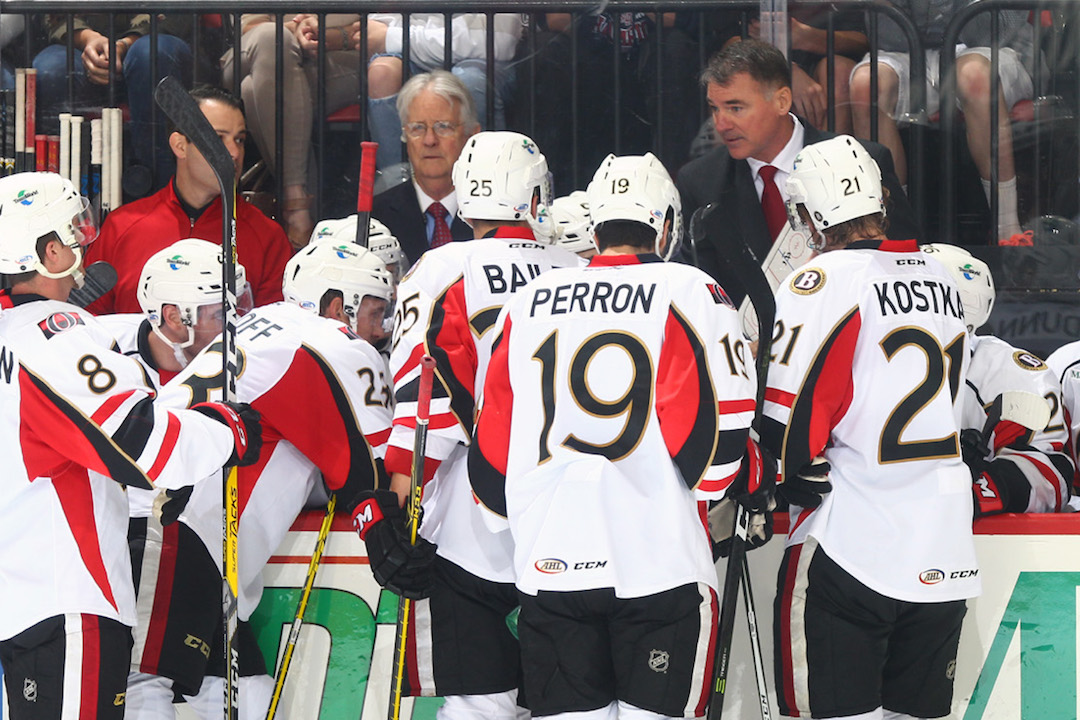By Nicole Del Villano | AHL On The Beat
Six years ago, the Binghamton Senators brought the first Calder Cup back to the Southern Tier led by head coach Kurt Kleinendorst. After the following season, Kleinendorst and the Senators’ organization decided to part ways, and it has been a move the coach has thought about over the past years.
“It [leaving] was my biggest professional regret,” said Kleinendorst. “There’s something about the Ottawa Senators and also the Binghamton community that I just had a special appreciation for.”
Kleinendorst’s appreciation was so strong that when it came time to renew his contract for the 2016-17 season with the ERC Ingolstadt of the DEL, he negotiated a way to come back. Kleinendorst traveled to join the European team in November of 2015 as head coach and was in the process of being brought back for the following season. While the team was not willing to put an open ended clause for Kleinendorst to pursue other opportunities if they arrived in the contract, the two parties were able to agree to a one-team out.
“I decided that just to be sure, I wanted to leave myself an option to come home if anything presented itself,” said Kleinendorst. “So I said, ok then I just want to make sure that if something opens up in the Ottawa organization I have the opportunity to go back.”
The opportunity would arise during the summer of 2016 after Binghamton Senators head coach Luke Richardson chose to pursue other coaching jobs outside of the organization. The Ottawa Senators staff immediately turned their attention to finding a replacement coach according to assistant general manager Randy Lee. After a lengthy interview process with over 20 coaches applying, the short list was cut to five names before Kleinendorst got the job.
“We knew that [Kurt] had expressed some interest,” said Lee. “The strongest thing we like to see is he is very disciplined… I think he treats the players with respect and the players know that under him they are going to get better.”
Kleinendorst’s style of coaching was also one that was a big factor in Ottawa being interested in bringing him back.
“He is from the New Jersey, Lou Lamoriello-type of system where he is familiar with the National Hockey League team playing the same system as the American Hockey League team. He has embraced that and for the players getting recalled it is much easier for the transition on the call up,” said Lee.
After getting the job, Kleinendorst not only returned to the town that he had brought a championship but also to the assistant coach he had worked with to do so.
Kleinendorst and Stirling’s History
Kleinendorst grew up in Grand Rapids, Minnesota, that had a population of 7,265 people and was a hockey hotbed. The passion for the sport was evident and Kleinendorst felt himself pulled in when he began to play. He attended Providence College where he played for Lamoriello and his connection with Steve Stirling began.
Despite Kleinendorst graduating the season prior to Stirling taking over as head coach, both men worked with Lamoriello and adopted his style. The connection carried into the early 2000s during their time in the NHL and AHL.
Their paths crossed with Kleinendorst working as a scout in the New Jersey organization while Stirling was on the coaching staff of both the Lowell Lock Monsters and the Bridgeport Sound Tigers. When Stirling was appointed head coach of the New York Islanders, a time came up when he needed an assistant and Kleinendorst came to mind.
“His experience was a good thing. I knew he worked for Lamoriello, who is a very detail oriented manager, and I worked for [Lou] too my first two years in Providence,” said Stirling. “I knew [Kurt] was organized and if he had worked for [Lou] he had to be detail oriented. All those things were what I was looking for in a partner.”
Kleinendorst ended up not taking the job with the Islanders instead waiting for his chance for a head coaching position in the AHL. That opportunity came about in 2006 when he became the head coach of the Lowell Devils for the next three seasons. Prior to the 2010-11 season, Kleinendorst joined the Senators’ organization and was in search for an assistant coach to join him in Binghamton.
“I had actually called [Stirling] about somebody he had worked with when I was looking for an assistant coach. [Steve] hadn’t really crossed my mind, so I had reached out to him to qualify somebody I was interested in,” said Kleinendorst. “He just told me the other guy had just taken a job somewhere else, which was true, but if I was looking for someone he would have an interest working with me. I went from him offering me a job to me offering him a job.”
The duo worked together and in their first year brought the Binghamton Senators to a Calder Cup championship. After a 42-30-3-5 regular season, the team went on a run in the playoffs bringing the first championship title to the Southern Tier. The connection both coaches made with the community was also a factor in where they wanted to continue their career.
Hockey in Binghamton
Coaching in Binghamton was not Stirling’s first opportunity to be in the area. The coach spent a year playing with the Broome Dusters of the NAHL in 1975.
“If memory serves me right, we had over 4,000 people in here a night because hockey was new to [the community],” said Stirling. “Coming back some 35 years later nothing has changed but in a positive way. The people [still] love their hockey and team. They know the game and know it pretty well.”
Kleinendorst has always echoed the same sentiment of the community during his time coaching and when he voiced his desire to come back.
“I think Binghamton is one of the most underrated communities that I have had the opportunity to experience,” said Kleinendorst. “The people are friendly, genuine, supportive and passionate. There are a lot of good things about the Binghamton community. I just think it is a wholesome place.”
By putting themselves in the community during their careers, both men made notes of the changes throughout the Southern Tier and the Arena. Despite losing big corporations in the past, Binghamton has started to grow again as Stirling noticed in the downtown area due to the college. After being away for three years, Kleinendorst came back to an upgraded Arena with new locker rooms, boards, lights and scoreboard to name a few. While there may be physical changes, the coaches continue to feel the same support from the fans.
“[In my time] in other buildings I have heard boos to the home team [from the home crowd]. I can honestly say that I can count on one hand the number of times over the years that the [B-Sens] crowd has booed the home team, and that says a lot about them. They are respectful of us and are patient with our young guys in development,” said Stirling.
Having such a supportive town behind a team that can face adversity throughout the season with injuries, call-ups and many moving pieces is something that Kleinendorst does not take for granted.
“There is nothing that I can say negative about Binghamton, this experience living here or even the players playing here,” said Kleinendorst. “I still to this day say the NHL is the best league in the world hands down. The most difficult league in the world to participate in is the AHL. There are so many variables we have to deal with that most teams in other leagues do not have to deal with. There is no other league like the AHL.”






































